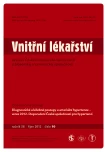Acute myocardial infarction in young adults – what is wrong? – editorial
Authors:
P. Toušek
Authors‘ workplace:
III. interní – kardiologická klinika 3. lékařské fakulty UK a FN Královské Vinohrady Praha, přednosta prof. MUDr. Petr Widimský, DrSc., FESC
Published in:
Vnitř Lék 2012; 58(10): 713-714
Category:
Editorial
Sources
1. Želízko M, Vojáček J, Kala P et al. Přehled vybraných kardiovaskulárních intervencí v České republice 2009. Praha: ÚZIS ČR, NRKI 2011.
2. Panagiotakos DB, Rallidis LS, Pitsavos C et al. Cigarette smoking and myocardial infarction in young men and women: a case-control study. Int J Cardiol 2007; 116: 371–375.
3. Lawesson SS, Stenestrand U, Lagerqvist et al. Gender perspective on risk factors, coronary lesions and long-term outcome in young patients with ST-elevation myocardial infarction. Heart 2010; 96: 453–459.
4. Schoenenberger AW, Radanovic D, Stauffer JC et al. Acute coronary syndromes in young patients: presentation, treatment and outcome. Int J Cardiol 2011; 148: 300–304.
5. Liu K, Daviglus ML, Loria MC et al. Healthy lifestyle through young adulthood and the presence of low cardiovascular disease risk profile in middle age: the coronary artery risk development in (young) adults (CARDIA) study. Circulation 2012; 125: 996–1004.
6. Stamler J, Stamler R, Neaton JD et al. Low risk-factor profile and long-term cardiovascular and noncardiovascular mortality and life expectancy: findings for 5 large cohorts of young adults and middle-aged men and women. JAMA 1999; 282: 2012–2018.
7. Rubin JB, Borden WB. Coronary heart disease in young adults. Curr Atheroscler Rep 2012; 14: 140–149.
Labels
Diabetology Endocrinology Internal medicineArticle was published in
Internal Medicine

2012 Issue 10
Most read in this issue
- Vitamin C and its physiological role with respect to the components of the immune system
- Sarcoidosis – diagnostics, prognosis and therapy. A retrospective analysis
- Acute myocardial infarction in young patients – severe failures in the system of acute and secondary care
- Febrile pancytopenia and hepatosplenomegaly as leading symptoms of visceral leishmaniasis
